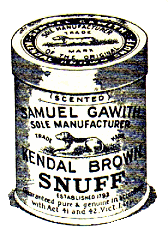

Tobacco Boxes
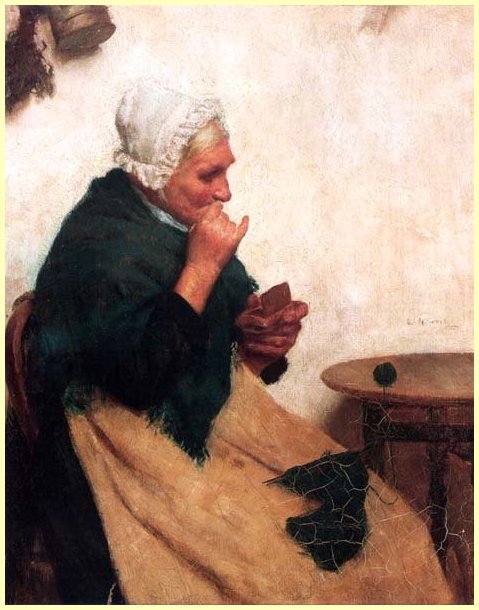
A Scottish women takes snuff from a snuff box of wood or horn.

Early Tobacco and Snuff Boxes
The first tobacco boxes were small as tobacco was a luxury and a costly commodity. The bowls of the pipes were small and the boxes needed to carry the tobacco were small as well. By the early mid 18th Century tobacco boxes were being produced in the Netherlands in brass and silver and sold all over Europe and the Americas. They grew in size as the price of tobacco was reduced and the size of pipe bowls increased.
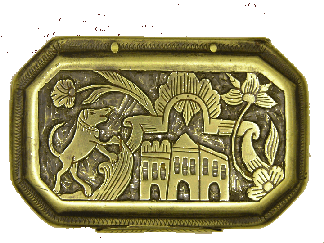
17th or18th Century Swedish Tobacco Box
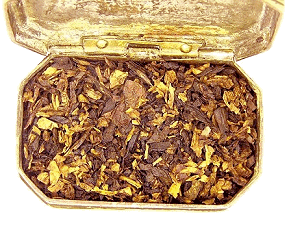
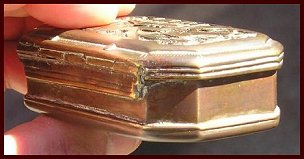
The lid is hinged and the back shows a very sturdy hinge
There is a possiblity this is Dutch but I think it is Swedish from the engraving style.
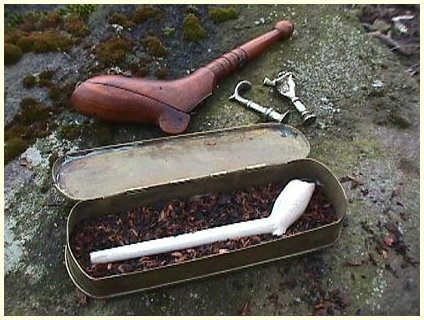
Typical long brass Tobacco box from Holland,
late 18th or early 19th Century
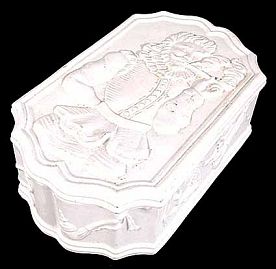
19th Century Style Italian Ceramic Tobacco Box
Snuff began to take over from smoking clay pipes as the most popular form of tobacco in Europe by the early 1700s. Inhaling tobacco in powder form was first practiced by the Arawaks of the West Indies, from whom this habit was brought to Europe at the end of the 15th century. By the 1700s it had become socially acceptable and thus gave rise to a wide range of smaller boxes . The definition of SNUFF (from to snuff, i.e. to inhale, to draw in through the nose; cf. Dutch snuf, scent, Ger. Sc/Inupfen, a cold, catarrh, and Eng. snuffle, sniff, &c.), the name of a powdered preparation of tobacco used for inhalation. The practice of inhaling snuff became common in England in the 17th Century, and throughout the 18th century it was universal. At first each quantity inhaled was fresh grated (Fr. rdper), whence the coarser kinds were later known as rappee. This entailed the snuff-taker carrying with him a grater with a small spoon at one end and a box to hold the grated snuff at the other. Early 18th-century graters made of ivory and other material still can be found in museum and private collections. Later the box and the grater were separated. The art and craft of the miniature painter, the enameller, jeweller and gold- and silver-smith was bestowed upon the snuff box. The humbler snuff-takers were content with boxes of silver, brass or other metal, horn, tortoise-shell or wood. The Seventeenth century Snuffer, bought his Snuff, in a partially-manufactured state, in the form of a solid roll of hard tobacco a few inches long. Descriptively called a "Carotte". When he wanted to produce some Snuff, the carotte was rubbed against a grater or tobacco rasp. The collected gratings were fine tobacco powder known as snuff. Furthermore the boxes people carried their snuff in ususally were hinged or fitted with very tight fitting lids so as to keep snuff from sifting out into their pockets. In time mills sprung up that produced snuff in large quanties such as the Sharrow Snuff Mill. Six generations of the Wilson family have followed Thomas at Sharrow Mills and the business which is now known as Wilsons & Co. (Sharrow) Ltd. is still wholly owned and run by members of the Wilson family.
"Snuff is tobacco ground or grated to a powder fermented and moistened with attar of roses, lavender, cloves, mint, jasmine, or many other substances, and sniffed (or sometimes rubbed inside the mouth, but this was a lower-class taste. It became known in Europe very early after the first discovery of tobacco in the New World. It began in Spain, naturally enough, then spread to Italy and France, where it became the rage in aristocratic circles. The word itself is Dutch. Snuff was known in England in 1600 but at first smoking tobacco in a pipe was more common, snuff did not become really popular until the 18th century, and was already fading a bit by 1817."
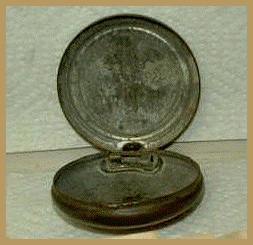
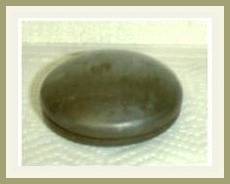
In its heyday, the taking of snuff became highly ritualized. The design and manufacture of snuff boxes became an art, making use of every kind of metal, porcelain and ivory. Snuff boxes were elegant and expensive personal effects, and soon became collectors' items. Wealthy and fashionable men would have a fair number of them and also give them as gifts. The recipes of the snuff- makers were elaborate and secret. The process of making snuff could take several days. In 19th-century England the tables turned again as the fashion for snuff declined sharply as briar tobacco pipes evolved and came into wider use. By 1850, 90% of tobacco users smoked rather than sniffed their tobacco.
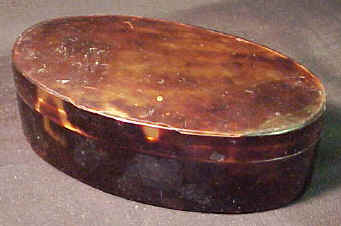
The French were direct importers of tobacco and tobacco products from almost as early a time as the English but France also became, and remains, the center of tobacco cultivation in Europe. The French have their cultural equivalent of Sir Walter Raleigh, the man credited with the first importation of tobacco into England. André Thévet, a cobbler from Angoulême in South West France, is said to have grown tobacco in his garden from seed supplied by sailors. Sailors, especially those from seafaring Brittany, were in fact the first importers and users of snuff as fire regulations on board ships banned smoking. In the 16th and 17th centuries snuff was in almost universal use in France from peasants through the clergy up to the nobility, who found taking snuff more elegant than smoking tobacco.
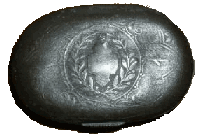
English box 19th Century Spelter or Pewter
Snuff taking trickled downwards through all classes of society in the 18th and 19th centuries. Boxes were produced in a wide variety of materials to suit every one from royalty to the humblest folk. Today silver snuff boxes are still reasonably plentiful as are those fashioned in pewter and brass. Brass snuff boxes are relatively inexpensive and can still be found on the market. Wood, mother-of-pearl, ivory, paper mache and even leather were used in the manufacture of snuff boxes. Sea shells, especially large cowries, were fitted with a silver rim and hinged lid. Horn and bone were also popular, particularly in Scotland. Such boxes might also be mounted with cairngorms or other semi-precious stones such as colorful agates. Even polished cattle hooves were made into handsome snuff boxes with pewter or silver fittings by Scottish artisans. Snuff is of course, ground tobacco, and was used nasally. It was not chewed as is the custom in the US currently. Taking snuff in Scotland became popular in the early 17th Century, before it took hold in England. The association of the Scottish and French courts brought the habit to the northern kingdom soon after snuff made its appearance in Europe. By the 18th Century, it had become popular throughout the British Isles, and mills were set up to grind the tobacco around the country. Samuel Gawith and Gawith & Hogarth manufactured snuff in the north of England long before they became famous for their pipe tobaccos. Today nasal snuff or Scotch snuff as it is sometimes called is making a comeback in Europe. For a pipe smoker like myself this is rather surprising as putting tobacco up my nose makes me shudder! I once thought Scotch snuff was truly a thing of the past.
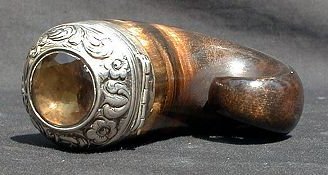
Silver, cairngorm and cow horn are exquisitely coupled to make this fine small mull.
While snuff boxes are reasonably well known, they are only part of the culture of snuff taking. Snuffs were portable boxes that were small and meant to be carried on the person. The demand for snuff created the need for something bigger; when you consider the quantities used (Napoleon used over 80 pounds per annum, Lord Nelson packed large bundles of snuff for sea voyages), the need for table-top containers becomes clear. Almost like a master salt, the snuff mull stood on the table or sideboard to serve all. The snuff mull is a large sort of oversized snuff box. The word Mull comes from a Scots dialect word for mill, the snuff having been ground in a mill to a powder, or meal very much like pepper is ground today. While these Mulls came in a variety of shapes, the most common are ram's horns mounted in silver or pewter. In addition to the horn mull, the entire ram's head, again with silver mounts, was sometimes used to create snuff mull. These large mulls, sometimes mounted on wheels, contained very large quantities of snuff, and were often used by fraternal organizations or regimental messes. The various accoutrements associated with snuff (spoons, brushes, and the like) were sometimes attached by chains to the mull. (See photo below.)
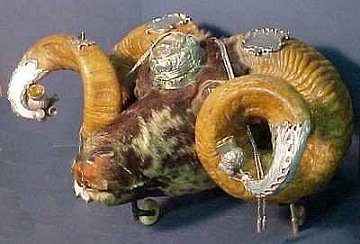
Late 19th Century Scottish Snuff Mull made from a
Rams Head with silver fittings and Cairngorm stones!


Some Snuffy
LINKS

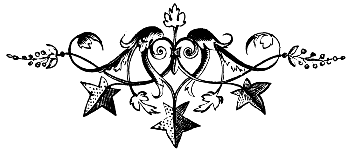
Copyright 2007 , Jim & Beth Boyle, All Rights Reserved
No part of this website may be used for any purpose ( including using images )
without written consent from The Rams Horn